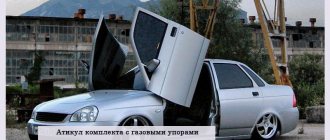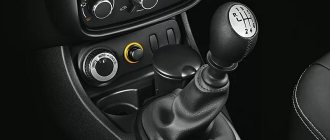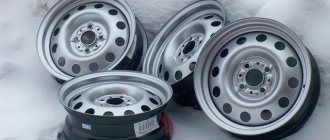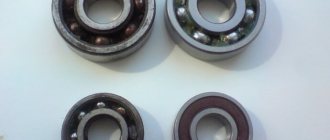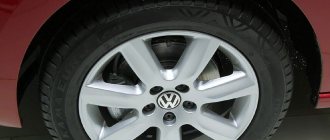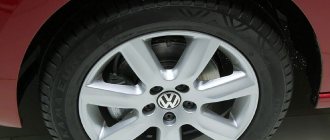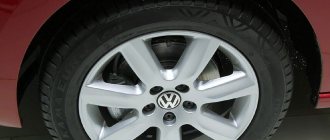Gasoline cans can be useful for motorists on long trips through sparsely populated areas where there are few gas stations, or when you need to wait until you get to a gas station of a certain brand and avoid refueling at a “no-name” gas station.
Also, canisters, as assistants, are indispensable for owners of motorcycles and gasoline-powered equipment: ATVs, chainsaws, lawn mowers, snow blowers and others. Let's find out what types of canisters there are, whether all canisters are filled at gas stations, and how to choose the best canister. When choosing a canister, you should pay attention to the following parameters:
- compliance with standards for the transportation and storage of flammable materials;
- volume;
- design;
- form;
- material;
- corrosion resistance;
- closing reliability;
- neck diameter;
- internal pressure that the canister can withstand;
- resistance to deformation;
- Ease of use.
Volume
Gasoline cans are divided into several groups by volume:
- small 5 liters;
- average 10, 20 liters;
- large 30, 40, 50 liters;
- fuel canister tank 100 liters;
- industrial 250-1000 liters.
There are canisters of other sizes, but they are not so common and are not in great demand. For personal use for storing and transporting gasoline, the most popular canisters are 5, 10, 20 liters.
The declared volume of the canister may not correspond to reality. According to safety rules, gasoline can be poured into a canister up to the bottom of the neck. If the canister is 20 liters, then this volume should fit exactly up to this level.
Most canisters have an air pocket at the top, which serves to compensate for the increase in fuel volume when heated and to provide buoyancy. It is forbidden to fill a canister with gasoline up to the top of the neck and completely by tilting the canister with the neck up and using the air pocket.
Small and medium canisters of 5-20 liters are convenient for transportation in the trunk. Large cans are mainly used for storing fuel in a garage or country house.
Best canisters with tap
Rating:
- Pressol (5-20 l, vertical, tap mounted in the body, Germany)
- Behroplast (5-60 l, vertical, built into the body, Germany);
- Sanplatec (5, 10, 20 l, vertical, built into the body, Russia);
- AceCamp Accordion Jerrycan (5.8, 10 l, folding, lid with tap, Germany).
They are distinguished by the presence of a tap for easy draining of liquid.
The design includes:
- capacity;
- drain tap;
- a lid covering the neck.
Crane installation options:
- in the lid;
- mounted into the canister at any level.
Manufacturers offer ready-made lids with a tap that are used with standard canisters. It is only necessary to choose the correct diameter of such a cover.
For example, an “Extreme” cap tap (Russia) with an internal diameter of 55 mm is suitable for a canister with a neck diameter of 55 mm.
Designs of containers with a tap:
- vertical;
- horizontal;
- folding;
- expeditionary;
- on wheels.
Pros:
- convenience of draining water (on trips and expeditions where there is no drinking water);
- used for washing and washing dishes in places with difficult access to water.
Minuses:
- may open if shaken in the car or in contact with other things;
- where the faucet is installed, low-quality plastic cracks and allows water to pass through;
- more expensive than models without a tap.
Design
The design of canisters is:
- vertical
- the most common, they are convenient to carry, but during transportation they require additional fastening to prevent them from tipping over. The side walls should have stamped stiffening ribs that increase the strength of the container. - Horizontal
- with a wide base, such canisters are longer than they are high. Due to the horizontal distribution of the center of gravity, the risk of the canister tipping over during transportation is eliminated. The neck is located at the top; the canisters are often supplemented with a tube that simplifies the process of pouring fuel into the tank. - Combined
or two-section canisters consist of two containers. Fuel is poured into one, adhesive oil for chainsaw chains or motor oil into the other. These canisters are in demand among owners of garden equipment and gasoline-powered tools, which require adding motor oil to gasoline to refill.
According to their design, canisters are also divided into:
- solid
- the most common canisters; - folding
- these are polymer heat-resistant elastic canisters, popular among owners of ATVs, jet skis, motor boats, yachts, and snowmobiles; - backpack
- designed in the form of a backpack that can be carried on the back. Used by the military and tourists.
Each canister consists of the following elements:
- tank
- neck
- lid
- pen
Neck
The neck can be located in the center of the upper wall of the canister or shifted to the edge. The offset neck is more convenient and safer, as it provides an air cushion above the surface of the fuel and a smooth flow of fuel when pouring, without gurgling or pulsation.
A siphon tube must be built into the neck, which ensures the flow of air into the canister when pouring fuel. The neck seal must be of a design that does not prevent complete emptying of the canister. If it is made like a sippy cup, then you won’t be able to pour out all the gasoline completely.
Neck diameter:
- with a wide neck 50-90 mm;
- with a narrow neck 29-45 mm.
The diameter of the neck affects the speed of fuel transfer: through a narrower neck, liquid pours out more slowly.
Lid
Canisters have two types of lids:
- Threaded plug
— screw connection with thread and a cover made of stainless steel or plastic with a gasket made of oil-gasoline-resistant rubber. The threaded cap must be screwed on firmly to prevent fuel leakage. Over time, it corrodes and becomes difficult to twist. To improve rotation, you can lubricate it with oil. - Retainer
- clamping mechanism. The clamping mechanism is considered more reliable than a threaded cap. But in extreme heat, under the pressure of the vapors generated in the canister, the internal pressure can be so high that the clamp can break.
Sealing gasket
A gasket must be present with any lid closing mechanism. It has a very important function - it provides sealing inside the canister, thereby preventing evaporation and leakage of fuel.
There are two types of gaskets:
- gaskets made of oil-gasoline-resistant rubber
(MBR). They are used in fuel environments where the base is oil or gasoline. This rubber can withstand temperature changes from -30ºС to +80ºС. When exposed to fuel mixtures, MBS rubber retains its shape, structure and elasticity. Such gaskets eliminate gaps between surfaces, withstand shock loads and prevent the leakage of gasoline, diesel fuel, kerosene and oil. - Gaskets made of ethylene propylene rubber
(EPDM). They are mainly used when working with solvents, acids, alkalis, and alcohols. In the automotive industry, they are used to make door, hood, trunk seals, pipes, tubes, hoses, and gaskets.
A standard factory gasket must be included with the new canister. Over time, it can become unusable and lose its original properties. Then you will need to buy a new one, choosing the right size.
Pen
The handle is located at the top of the canister; it should be comfortable for carrying the canister and have a comfortable grip when pouring fuel. Sometimes metal canisters have three identical handles next to each other.
This design has three advantages:
- allows one person to carry a canister, or two people to carry one canister;
- one person can carry two empty canisters in one hand;
- It is convenient to transfer such canisters to each other along a chain.
Such containers are used mainly by the military.
History[edit]
The canister's name refers to its German origins, Jerry
means Germans in slang. [4] [5] The design was reconstructed and subsequently copied with minor modifications by the Allies during World War II.
German invention[edit]
Wehrmacht-Einheitskanister
, as it was known in Germany, was first developed in 1937 by the Müller engineering firm in Schwelm to a design by its chief engineer Vinzenz Grünvogel. [6] A similar design was used in 1936 during the Spanish Civil War, [7] where they had a company logo for Ambi-Budd Presswerk GmbH. Among other things, the Wehrmacht specified that a soldier should be able to carry either two full containers or four empty ones, so triple handles were installed. To achieve the required filling and draining speed, it was equipped with a large spout and a hinged lid. The hole in the lid latch allowed the installation of a locking pin or wire with a lead seal. Thanks to its rectangular shape, it could be stacked. The recessed weld seam gave the container rigidity and protected the seam from damage upon impact. The dents ensure that the full can will not be seriously damaged if dropped from the car, while a coat of paint on the inside protects it from corrosion.
By 1939, the German military was stockpiling thousands of these cans in anticipation of war. Motorized troops were issued canisters containing lengths of rubber hose to siphon off fuel from any available source, facilitating their rapid advance through Poland at the start of World War II. [8]
American adaptation[edit]
Several American style canisters at the Savannah Quartermaster Depot, Savannah, Georgia, 1943.
In 1939, American engineer Paul Place and his German colleague built a car to travel to India. After building the machine, they realized that they had no storage for emergency water. A German engineer had access to a warehouse of canisters at Berlin Tempelhof Airport and managed to capture three of them. They crossed 11 state borders without incident until Field Marshal Goering sent a plane to take the engineer home. The German engineer also provided Pleiss with complete specifications for making the can. [8] Place drove to Calcutta, stored the car, and flew back to Philadelphia, where he told the American military about the bank. He could not generate interest.[8] He realized that he couldn’t go anywhere without a sample. He eventually sent the car to New York via a circuitous route and sent the can to Washington. The War Department decided instead to use World War I ten US gallon (38 l; 8.3 imp gal) tin cans with two screw caps that required both a wrench and a funnel to pour. [8]
The only canister in American possession was sent to Camp Holabird, Maryland, where it was upgraded. The new design retains the handles, size and shape, but is most easily distinguished from the German original by the simplified "X" - the stiffening ridges on the sides of the can. US can be stacked interchangeably with German or British banks. The German recessed weld was replaced with rolled welds, which were prone to leaks. The lining was removed from the fuel tanks and a wrench and funnel were required. [8] A similar water jar with a hinged lid and enamel lining was also adopted.
The American-made canister was widely used in units of the US Army and Marine Corps. In all overseas theaters, fuel and other petroleum products accounted for about 50% of all supply requirements measured by weight. [9] In the European Theater alone, by May 1945, more than 19 million men were needed to support American forces. [9]
The canister played an important role in securing fuel supplies for Allied operations. One standard 2.5-ton US truck could carry 875 US gallons (3,310 L) of fuel loaded in cans. [9] American logisticians requested more than 1.3 million per month for damages; these cans were provided by manufacturers in the US and UK, but supply could not keep up with demand. [9] Unit losses of canisters were severe: for example, in October 1944, a "loss" of 3.5 million was reported. [9] At one point in August 1944, a canister shortage (caused by casualties) effectively limited the supply of fuel that could be delivered to combat units, although fuel was available in rear areas. [9]
The US design was slightly lighter than the German can (10 lb (4.5 kg) versus 11.5 lb (5.2 kg) for the German version). [9] These fuel tanks were subsequently used in all theaters of war around the world. [8] Such was the importance of cans in the war effort that President Roosevelt's administration Fr.
- British stamped steel 2 gallon jerry cans - durable but heavy and expensive
- British tin, 4 gallon petrol can ("Flimsy"). Inexpensive, but weak and prone to leaks
When the British Army first saw German fuel cans during the Norwegian Campaign in 1940, they immediately saw the benefits of the superior design. Three handles made it easy to operate by one or two people or to use a crew-style bucket. The handle design also allows you to carry two empty cans in each hand using the external handle.
The sides of the can were marked with cross-shaped indentations that strengthened the can, allowing the contents to expand, as did an air pocket under the handles when the can was filled correctly. This air pocket allowed the container to float when dropped into water. Instead of a screw cap, the containers used a cam lever release mechanism with a short spout secured with a clasp and an air pipe into an air pocket that allowed the fill to be smoothed out (which was omitted in some examples). The interior was lined with an impermeable plastic first developed for steel beer barrels, allowing the can to be used for both water and gasoline. The cylinder was welded and had a gasket for a sealed neck.
The British preferred canisters captured from the "Gerrys" (Germans) as much as possible - hence the "canisters". Later in 1940, Place was in London and British officers asked him about the design and production of the canister. Place ordered the second of three canisters delivered to London. [8] After the second capture from Benghazi in late 1941, large numbers of Axis canisters were captured, enough to equip several units such as the Long Range Desert Group. [10]
British companies such as Briggs Motor Bodies, Vauxhall Motors and the Pressed Steel Company produced copies of the German design.
- British fuel cans used in April 1944 during training in England in preparation for the Allied landings in Normandy.
- British copy of German design
- A British soldier fills a truck with petrol from a can.
Russian usage [edit]
The strength of the Wehrmachtskanister
was determined in the Soviet Union. Its design was later copied and the Soviet Army adopted it as a standard liquid container. This container is still produced and used in modern Russia. For civilian purposes, this container is mainly used for automobile fuel and lubricants. [12]
Modern use[edit]
The US Blitz can is attached to a holder in the rear of a Mitsubishi Type 73 light truck.
Swedish version of the canister stored on each side of the Stridsvagn 103.
The German-designed canister is still the standard container for fuel and other liquids in NATO armies.
Finnish designer Eero Rislakki developed a plastic canister in 1970 with a small screw-on cap on the top side behind the handle, allowing air to flow in and allowing fuel to flow out smoothly. It is lighter than the original, but almost as durable. It was quickly adopted by the Finnish Armed Forces and is commercially available.
Canister material
Canisters for gasoline, diesel fuel and kerosene are made from the following materials:
- steel
- galvanized steel
- stainless steel
- aluminum
- plastic (polypropylene, elastic polyethylene)
Let's take a closer look at the canister made from each material.
Steel cans
Steel is a lightweight material that is resistant to chemical influences (in particular gasoline), but is highly susceptible to corrosion. Steel canisters are most often produced in a classic rectangular shape. They are produced by stamping from sheet steel with a thickness of 0.6-0.8 mm, followed by welding of the side seams.
Stiffening ribs are additionally stamped on the side walls. The outside is powder coated to protect against rust and baked in a thermal oven at 300°C. This ensures the strength and durability of the coating. Also, instead of paint, they can be galvanized inside and out, for example, galvanized cans.
The locking device is a metal plug with a thread or a clamping-lever mechanism, which are sealed with an oil-gasoline-resistant gasket. They can be equipped with a flexible plastic drain tube and an overpressure valve.
Different manufacturers, in order to reduce the cost of canisters, save at various stages of production, so when choosing the cheapest version of the container, you should not expect good quality: the paint may begin to fall off, the gasket may be made of ordinary rubber and gasoline will corrode it, the cap may leak, the canister may begin to rust from the inside with poor treatment of internal surfaces, etc.
Advantages of a steel canister:
- a light weight,
- resistance to gasoline,
- high mechanical strength.
Disadvantages of a steel canister:
- susceptible to corrosion processes;
- corrosion products inside the canister enter the fuel;
- If the steel is thin, the canister may become deformed due to mechanical shocks and temperature.
Stainless steel canisters
Stainless steel is an alloy steel (steel with additives) that is resistant to corrosion and chemical attack. The canisters are made of stainless steel sheet with a thickness of 0.6-0.8 mm. Withstands internal burst pressure of 0.2 MPa.
Most have a classic rectangular frame with a vertical or horizontal design. Available in various volumes: 2, 3, 5, 10, 20, 25 l. Stainless steel canisters are the most durable, resistant to external chemical and mechanical influences, and do not require additional surface treatment.
Advantages of stainless steel canisters:
- unlimited shelf life,
- corrosion resistance,
- resistance to mechanical shocks,
- high temperature resistance,
- chemical resistance,
- large selection of models by volume,
- beautiful appearance that does not deteriorate over time.
Disadvantages of stainless steel canisters:
- very high price
- heavy weight of the canister.
Aluminum canisters
Aluminum is a lightweight, soft, medium-strength material that does not corrode. Most have a classic rectangular shape with a vertical design. There are volumes of 5, 10, 20 liters. The maximum internal pressure at which the housing is sealed is 0.2 MPa.
They can be manufactured with or without an air bag. The former are preferable, since when heated, the liquid expands and enters an air bag, which is connected to the neck using a siphon tube.
The welding handle must withstand double the weight of a canister filled with water.
Advantages of an aluminum canister:
- a light weight,
- resistant to chemical attack,
- high anti-corrosion resistance (do not rust),
- durable,
- allow you to store gasoline for a long time,
- cheaper than steel
- possibility of recycling.
Disadvantages of an aluminum canister:
- soft, easily deformed under mechanical stress;
- difficult to clean;
- are available in one form.
Made from sheet aluminum, the inner surface of the canister is etched to prevent the formation of aluminum oxide. This protects gasoline from contamination by fine oxides, but over time this protection gradually decreases.
Plastic cans
Plastic canisters are made from petrol-resistant polypropylene and elastic high-density polyethylene (HDPE) using the extrusion blowing method with the addition of dyes, antistatic and ultraviolet additives. Antistatic additives prevent the accumulation of static electricity, so such canisters do not “spark” when refilled.
Since food (water, milk, oil) and technical (motor oil, solvents, coolants, fuel, etc.) liquids can be stored in plastic canisters, there are an abundance of plastic canisters in stores, which makes it difficult to choose a suitable container for gasoline. You can rely on the seller’s advice only if he is well versed in this issue.
Is it possible to refuel at a gas station in a plastic canister?
A plastic gasoline canister must have a number of characteristics and meet mandatory requirements. Otherwise, you may encounter a refusal to fill a plastic canister at a gas station. Not all plastic can be filled with fuel: an unsuitable canister can burst, become deformed, catch fire, break, dissolve, and gasoline can seep through the walls of the container.
That is why gas stations most often do not fill them in plastic cans. Previously, the rules for the technical operation of gas stations in the Russian Federation stated: “It is prohibited to dispense petroleum products in plastic and glass containers.” Both plastic and glass accumulate static electricity, which can cause a spark that could cause the contents of the canister to explode.
The gas station operator cannot check compliance with all the requirements; it is easier to refuse to refill plastic containers or offer to buy the canister that is sold at their gas station and meets all standards. As an option, take with you a certificate of conformity for a plastic canister.
Now there is a new GOST R 58404–2019, which came into force on June 1, 2022 and is called “Gas Stations and Gas Complexes. Rules of technical operation".
Let's go to paragraph 8.2.5: “Dispensing petroleum products in glass containers is not allowed. Dispensing petroleum products into containers made of polymer materials is permitted only if it bears the manufacturer’s marking indicating the possibility of its use for storing petroleum products. The volume of the container must be greater than the minimum dose delivered by the fuel dispenser, established by its manufacturer in the operational and technical documentation.”
When choosing a plastic canister for gasoline, you need to pay attention to the following points:
- plastic appearance . The plastic should be smooth to the touch. If it is rough and coarse-grained, this indicates that it is intended for oil or other vehicle fluids. The plastic should be very hard and smooth and not bend when pressed. It is better to choose a canister of bright colors. Canisters of dark colors with stains indicate secondary raw materials in their manufacture.
- Marking on the canister must comply with the requirements of the international agreement ADR (“Road Transport of Dangerous Goods”), which regulates the rules for the transportation of hazardous flammable substances. There must be a certificate of compliance with the requirements for the transportation of dangerous goods. The inscription “for technical liquids” is not suitable.
- Gasoline cans must be marked “UN Class Certificate” . It determines the permeability of the walls of the container. Gasoline is highly fluid and penetrating and can ooze through small cracks and pores in plastic. The fluidity and penetrating power of gasoline is higher than that of water, which is why gasoline should not be poured into unsuitable containers.
UN standards determine the permissible permeability of canister walls: - for 5-liter canisters - 0.0016 g/lh; — for 10-liter canisters — 0.001 g/lh; — for 20-liter canisters — 0.0009 g/lh.
- There should be stiffening ribs , which increase the resistance of the container with increasing internal pressure and mechanical loads. If you close the canister with a stopper and stand on it, it should practically not be pressed through and retain its shape. In the same way, you can check the tightness of the stopper and seams of a filled canister.
- Weight . A canister for gasoline weighs much more than a canister of the same volume for water, oil or technical fluids. More weight indicates high-quality plastic and thick walls. A 5-liter canister should weigh 500 g, a 10-liter canister should weigh 700 g, and a 20-liter canister should weigh at least 1 kg.
- The canisters are equipped with special funnels or threaded filler spouts . The advantages of the filling spout are that it is more compact compared to a funnel. The spout should screw tightly onto the neck. If it is put on loosely, then most likely, when pouring, gasoline will flow through this connection, and can get on your hands and the paintwork of the car or motorcycle. Gasoline is a strong solvent and is harmful to paint.
Advantages of plastic canisters:
- lungs,
- silent,
- chemically resistant
- easy to clean,
- low price.
Disadvantages of plastic canisters:
- deformation when exposed to high temperatures (for example, prolonged exposure to the sun);
- less durable than metal ones, may crack after a strong impact;
- over time, the canister may lose its antistatic properties;
- possible refusal of service at the gas station.
Storing gasoline in cans
Certain conditions are required for proper storage of gasoline. Its shelf life is limited, and the presence of impurities and due to constantly occurring chemical reactions, its properties deteriorate.
The maximum shelf life of gasoline is considered to be 5 years, but for this it is necessary to observe:
- storage temperature;
- container tightness;
- container material;
- no direct sunlight.
High temperature will reduce the performance of the fuel, some metals will increase oxidation, and non-sealing will promote evaporation.
That is why the shelf life of gasoline at home is considered to be 1 year, regardless of the material from which the container is made. The ambient temperature will directly affect the shelf life of gasoline. The higher the storage temperature, the shorter the shelf life of the fuel. Thus, in the southern regions, storage becomes possible for no more than 6 months, and in the northern regions it is extended to 2 years.
Storage in plastic has a negative impact on the fuel; it loses its quality characteristics, and the container may be subject to deformation under the influence of oxidation and chemical reactions.
Storage in mixing containers is not permissible, since they do not close hermetically, and the mixture itself retains its properties for no more than a week after combining the liquids.
When constantly storing gasoline containers in the trunk, the contents should be regularly updated to ensure the preservation of the quality characteristics of the fuel and to prevent the formation of sediment. Modern gasoline contains a large number of additives, which, if precipitated, can harm the car engine.
Steel cans
Horizontal canister 20 liters AUTOPROFI KAN-500 20L
Canister AUTOPROFI KAN-500 20L is a canister made of galvanized steel from the Russian brand AUTOPROFI, production is located at 30 enterprises in Russia, Taiwan and China. The canister is designed for transportation and storage of various fuels and lubricants, including gasoline.
It has a horizontal shape without sharp corners, is very stable during transportation, there is no risk of tipping over, and therefore does not require additional fasteners in the trunk. Volume 20 liters, three handles for easy carrying by two people. Empty canister weight 3.3 kg. The canister is coated with paint, which increases its resistance to corrosion and durability.
On the side walls along the perimeter there is a rubber edge that prevents contact with various objects and peeling off the paint. An adjustable air valve is built into the neck, which allows you to relieve pressure and speeds up the filling and draining of fuel. The valve is adjusted manually or with a screwdriver. The lid is made of steel with a gas-resistant gasket and comfortable grooves for fingers. The kit includes a long corrugated watering can, which is attached to the body.
Canister dimensions: length - 440 mm, width - 315 mm, height - 295 mm, weight 3.3 kg, volume 20 l. The color is red.
Metal vertical canister 20l Sorokin
Canister 20 l Sorokin is a metal canister of the Russian brand Sorokin, whose production plants are located in Russia, Europe, China and Taiwan. The canister is designed for storing and transporting various fuels and lubricants. The Sorokin 20 l canister is made of high-quality metal 0.6 mm thick, which is resistant to corrosion, and the outside is painted bright red.
The canister has an elongated rectangular shape, to prevent it from tipping over during transportation it will require additional fastening. The side walls are reinforced with stiffening ribs and hold increased internal pressure very well. The canister has three handles, which allows two people to carry it. The neck is narrow, located in the center, and is not equipped with an air valve, which leads to gurgling when pouring fuel.
Dimensions of the canister in the package: length - 345 mm, width - 165 mm, height - 460 mm, weight 2.4 kg, volume 20 l. The color is red.
Steel canister 20 l KS-20
The steel canister KS-20 is designed for storing and transporting fuel, oils and special liquids. Manufactured at the state enterprise "IK 8 - Search" in Belarus. Made from high-quality rolled steel with a thickness of 0.8-1mm. The canister is vertical, rectangular in shape. The outside is painted dark green.
Thick metal and side stiffening ribs provide resistance to increased internal pressure and mechanical shock. The neck is offset from the center; instead of a siphon tube, a plate is welded to the neck, which forms an air channel; the metal cover is equipped with a lever. The canister has three handles for easy carrying.
Canister dimensions: length - 345 mm, width - 165 mm, height - 468 mm, weight 4.95 kg, volume 20 l. The color is dark green.
Criterias of choice
I will say right away that Moscow, somewhere around the Prazhskaya metro station and in large markets for automobile parts and accessories, Irkutsk, Vladivostok and a number of other cities, including even small settlements, are ready to offer their residents special cans for gasoline. There are also a lot of sales points in St. Petersburg. Those who are especially lazy can go to Avito, order through Leroy Merlin and any other online store.
We recommend: 5 best hands-free devices for cars
I wouldn’t call the question of how much a container costs particularly relevant. Basically, the price is low, so you can buy yourself a suitable container cheaply without any problems.
I would advise relying on three main criteria:
- volume;
- material of manufacture;
- form.
For me, the optimal volume is 20 liters. I’ve already found myself in different situations when having a canister in the trunk helped out. Moreover, I realized for myself that 5 liters may sometimes not be enough if you have climbed far and the path to the nearest gas station is not the closest.
But it's up to you. If you want a compact container that barely takes up space in the trunk, take a 5-liter container. More thrifty people choose 10 or 20 liters.
It is much more important to buy a container that is made of materials that meet all the rules and regulations. Many people will immediately think that it must be exclusively plastic. Allegedly, a spark may occur from contact with a metal canister and everything will burn.
I propose to consider plastic and metal containers separately. Let's see what is actually the right choice.
Plastic
Plastic containers for gasoline are quite popular because they are cheap, lightweight and do not create unnecessary noise in the trunk.
For the production of canisters, special materials are used that are resistant to gasoline and are considered safe. But we are talking only about those canisters where their purpose specifically for petroleum products is clearly indicated. Plastic contains additives that reduce the ability of the material to accumulate static electricity.
A special sealed lid is provided for them, which will not allow the fuel to spill or evaporate during storage.
But plastic canisters have pitfalls that are important to be aware of.
- Plastic is not strong enough. Even the strongest plastic is inferior to metal. It is easier to damage and break.
- Current legislation in Russia prohibits gas station employees from pouring fuel into plastic or glass containers, since there is a risk of spark formation due to static electricity.
- If you arrive at a gas station and ask to put fuel in plastic, you will most likely be refused. Usually they require a metal container or a certificate that specifies the specification of a plastic canister for transporting petroleum products.
- Polymer (plastic) canisters are prohibited because the material is dielectric and can accumulate a charge. When pouring fuel from a container into a tank, there is a possibility that the charge will discharge on the metal body. Then a spark, boom and finish. Well, you know what I mean.
- Even specialized containers made of polymers are destroyed over time under the influence of gasoline. Fuel leaks, evaporates, spoils the smell in the trunk, and when in a closed space, a cloud of vapor forms. The risk of it igniting is quite high.
So if you need plastic containers, be sure to buy only specialized containers along with a certificate of conformity. By presenting it, I’ll probably fill you with fuel at the gas station. Although there are very basic gas stations where they will refuse to pour fuel into such a canister. Be prepared for this.
In Russia, a metal container with a volume of 20 liters is considered the most popular. I would include a long service life and high strength indicators as advantages.
All iron fuel containers are made from two materials:
- stainless steel;
- aluminum.
In general, simple steel options could be added here, but they rust over time, and corrosion particles end up in gasoline. It's better not to take them.
Each type is worth talking about separately.
- Stainless steel. The container is durable, strong and not particularly demanding on storage and operating conditions. Corrosion does not occur, there is no chemical reaction between metal and gasoline. The only negative is the high cost. Compared to competitors, stainless steel containers are the most expensive.
- Aluminum. With low weight, aluminum containers for gasoline are characterized by strength and reliability. Yes, they are a little inferior to stainless steel, but their price is appropriate. No rust, which is also a plus.
We recommend: 10 best car GPS navigators of 2020
If you have the opportunity to spend more money, then take stainless steel. If your budget is limited, aluminum is also an option. But not ordinary steel. It won't last long.
Again, I’m talking strictly about specialized canisters that are designed specifically for storing petroleum products.
Form
Everything is simple here. The shape of the container can be normal vertical or horizontal.
- Flat vertical containers are considered classics and have been produced since the middle of the last century. Many machines even have separate mounts for canisters. If there are no such fasteners, you will have to fix the container in the trunk using improvised means;
- Horizontal designs. The wide bottom and low height allow you to place the container in the trunk and not worry that it will tip over. No additional fastenings are needed. Convenient and practical.
As for me, the choice is obvious. Although everyone pursues their own goals and has their own views on the optimal container design.
Stainless steel
Metal canister 10 l REXXON
REXXON canister is a metal canister of a German brand, manufactured in Latvia. The canister is designed for storing and transporting gasoline, diesel fuel and other fuels and lubricants. Made from stainless steel 0.8 mm thick, painted green on top. It is highly resistant to mechanical damage, atmospheric conditions and aggressive chemicals.
For a long time it retains its presentable appearance and performance characteristics. The canister has a rectangular shape and a small height, which makes it stable. It is almost impossible to accidentally turn it over. The side walls are reinforced with stiffening ribs, the handle is located on top, and is comfortable and wide. The lid is equipped with a lock.
Canister dimensions: length - 350 mm, width - 165 mm, height - 283 mm, weight 2.8 kg, volume 10 l. Green color.
Stainless steel canister 10 l SOROKIN
The canister is designed for storing fuel mixtures and various liquids. Made in China under the trademark of the Russian company Sorokin. The canister is made of stainless steel sheet 0.8 mm thick and has increased strength. The canister is not subject to corrosion and therefore will retain its performance characteristics for a long time.
The canister has a horizontal rectangular shape, volume 10 liters. The neck is located in the center of the canister and has an overpressure valve built into it. The neck is equipped with a screw-on flexible plastic drain hose. A metal cap with a thread seals the neck tightly. Triple handle for easy carrying by two people.
Dimensions of the canister in the package: length - 360 mm, width - 225 mm, height - 205 mm, weight 2.9 kg, volume 10 l. Silver color.
The best canisters for drinking water
Rating:
- Tatonka Faltkanister (folding, volume 10 l, 20 l, lid with tap valve, Germany);
- Sea To Summit Pack Tap (folding, volume 10 l, 20 l, lid with tap valve, Austria);
- MO (solid cast, volume 10, 20, 28 l, threaded lid, without drain, JSC "BAK", Bashkiria-Russia);
- PRK (backpack, volume 6, 12, 21 l, filling and drain outlets, screw cap, SkyProm, Russia).
Designed for transporting and storing water supplies. The main requirement for such models is that drinking water should not oxidize for a long time. The container should not have any odor, otherwise it will affect the taste of the water.
By design there are:
- solid cast (classic models, convenient for stationary storage);
- folding (take up little space when empty, light in weight);
- backpack (in the form of a backpack with a volume of 6-21 liters, in demand among tourists and the military).
They are distinguished by the presence of a faucet for draining water, which is present in most containers of this type.
Material:
- plastic (antistatic polypropylene, polyethylene);
- aluminum;
- stainless steel.
Plastic models are most in demand due to their light weight and folding models. The Austrian Sea To Summit Pack Collapsible Canisters are made from two-layer foil covered plastic with a durable nylon cover making them super durable.
Pros:
- additional water supply;
- compactness;
- light weight;
- ease of transportation;
- tightness;
Minuses:
- limited shelf life of drinking water;
Plastic cans
Canister Oktan Profi 20
Oktan PROFI 20 is a plastic canister produced by the Russian company BRUMEX. The canister is vertical, its volume is 20 liters. The canister can be used for transporting and storing gasoline and various other types of fuels and lubricants. Made from high-strength frost-resistant plastic, it has a reinforced structure due to additional stiffening ribs, a reinforced seam at the bottom and thickened walls. This allows it to be used in extreme conditions.
There is a recess at the bottom of the canister for easy use. Larger diameter neck for faster pouring. A filler nozzle with an anti-bulk function is attached to the neck. The lid with a lock ensures a tight fit to the neck and prevents fuel leakage; the canister is equipped with a flexible filling spout. The handle is comfortable and wide.
Canister dimensions: length - 350 mm, width - 200 mm, height - 418 mm, weight 1.24 kg, volume 20 l. Green color.
Canister “Zvezda” 20 with collection funnel
The Zvezda 20 l canister is a strong, durable plastic canister made in Russia. Canister with a capacity of 20 liters, bright red, horizontal in shape. Suitable for transporting and storing both gasoline and diesel fuel. Made in Russia by blow molding from high-quality non-toxic and environmentally friendly high-density polyethylene (HDPE) with the addition of antistatic components.
Bright light coloring highlights high-quality virgin plastic, while dark, cloudy plastic with various inclusions indicates recycled plastic from recycled materials, which cannot be used for fuel cans. There are reinforced stiffening ribs on the side walls to withstand mechanical loads. The lid fits tightly to the neck and is equipped with a gas-resistant seal. The canister is equipped with a collection funnel for easy pouring of gasoline.
Canister dimensions: length - 540 mm, width - 200 mm, height - 382 mm, weight 1.30 kg, volume 20 l. The color is bright red.
Reinforced canister STELS 20 l 53127
Reinforced canister STELS 20 is a plastic canister of the Russian brand STELS, production is located in China, manufactured products are certified and meet European quality standards. The canister is designed for transportation and storage of gasoline and other fuels. Rectangular canister with a capacity of 20 liters. Made from extra-strong, petrol-resistant plastic of increased thickness. The set includes a spout for easy pouring of gasoline.
Canister dimensions: length - 360 mm, width - 180 mm, height - 410 mm, weight 1.20 kg, volume 20 l. Color green, gray.
Cross on the sides
Why did the canister have such an unusual design? The shape of the Wehrmachtskanister was calculated by anthropologists and turned out to be very convenient from an ergonomic point of view. The 453 mm height allowed the canister to be carried by hand without the risk of touching the ground and damaging the shin, as often happened with old 45-liter cans. 340 mm in length was half the stride of an adult, thanks to which the soldier could move freely in the cramped spaces of a truck or railway car without breaking his usual walking pace or touching other objects with the canister.
Question answer
How to make a firewood carrier from an old canister? The upper flat platform was used for stacking canisters. The hump with handles made it possible to create an air bag necessary to accept fuel during thermal expansion. It prevented gasoline from leaking out. And the locking mechanism made it possible to securely press the lid to the neck.
On the sides of the canister there was a strange stamping in the form of a rectangle with diverging “tentacles” in the form of a cross. This was done to give rigidity to the walls so that they would not swell when filled with gasoline and would not collapse when emptied. The stampings imparted rigidity to the entire structure and helped the canister to wrinkle less when dropped from a small height. This drawing was also calculated by engineers and turned out to be so successful that it has not changed for 80 years.
Aluminum
Aluminum canister 10 l Demidovsky Plant
The canister is made of aluminum in Russia at the Demidov plant, located in the Sverdlovsk region. The canister is vertical, with a volume of 10 liters, has a classic rectangular shape, with stiffening ribs on the side walls to increase resistance to increased internal pressure and mechanical loads. The canister is durable due to the corrosion resistance of aluminum. The neck is wide, offset from the center to the side, the siphon tube is not included.
Canister dimensions: length - 290 mm, width - 360 mm, height - 400 mm, weight 1.4 kg, volume 10 l. Silver color.
Aluminum canister 20 l Airline
The Airline-ACF-20A canister is designed for storing and transporting gasoline and other fuels and technical oils. A canister of the Russian brand Airline, made in China or Taiwan. The canister has a vertical rectangular shape, volume 20 liters. During transportation, it will require additional fastening so that the canister does not tip over. Made of aluminum 0.6 mm thick. Aluminum ensures the durability of the canister, giving it anti-corrosion resistance. The neck of the canister is elongated, offset from the center, the lid is plastic and screws on. One handle, wide, ergonomic.
Canister dimensions: length - 350 mm, width - 160 mm, height - 460 mm, weight 2.6 kg, volume 20 l. Silver color.
Price
The price of the container depends on the materials of manufacture, volume and quality, that is, it can cost more or less. The cheapest and most accessible is a plastic gasoline canister. On average, the price for a 5-liter container ranges from 250 rubles to 400 rubles, 10 liters - from 400 to 500 rubles, 20 liters - from 550 to 1000 rubles.
The cost of steel options ranges up to 800 rubles for 10 liters, 1500 rubles for 20 liters. One of the most expensive and reliable is an aluminum canister; it will be about 300 rubles more expensive than a steel one. You should not choose only by cost, because the main indicators are reliability and quality. They will prevent unforeseen situations and preserve the health of the owner.
Storage security
Avoiding spilling gasoline both indoors and in the car is a basic safety rule. It is necessary to monitor the canister itself (inspect for damage, cracks and abrasions), and especially the neck and lid. There are two types of closing system: a threaded lid and a mechanical one, using a special lock and seal. When purchasing a new 20-liter canister or other volume, you need to carefully check the lid for tightness. The seal, if provided, should fit as tightly as possible to the neck. It’s a big plus if the canister has a spout. These are very convenient when transferring fuel, there are fewer spills, and they are also convenient for storage - gasoline does not evaporate. Empty containers are stored with the lid not screwed on completely so that gasoline vapors do not accumulate.
